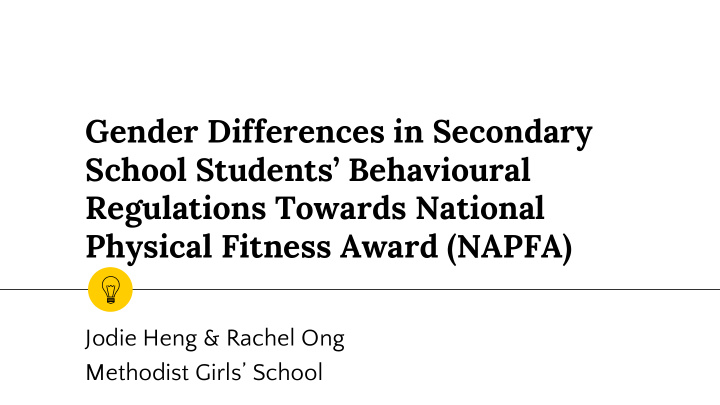



Gender Differences in Secondary School Students’ Behavioural Regulations Towards National Physical Fitness Award (NAPFA) Jodie Heng & Rachel Ong Methodist Girls’ School
Research Question Does gender affect students’ behavioural regulations towards NAPFA? 2
3 Hypothesis This project hypothesised that female students’ have less motivation, specifically internal motivation, to participate in NAPFA compared to male students. “
Introduction The National Physical Fitness Award (NAPFA); ◉ is a mandated test ◉ assesses the overall fitness ◉ understand the importance of a healthy and balanced lifestyle ○ Increasing trend of obesity ○ Decreasing trend of participation 4
Reasons for undertaking study ◉ Provide valuable insights ◉ A more suitable curriculum and test could be developed ○ Pique student’s interests ◉ No empirical data or studies available 5
Aims Find out, ◉ Secondary School Students’ behavioural regulations towards NAPFA ◉ Difference in behavioural regulations within gender Evaluate, ◉ The different motivations for participating in NAPFA 6
Methodology 7
Procedure ◉ Consent forms were given out to participants ◉ Google form questionnaire ○ explored the importance of NAPFA to the participants and the perceptions towards the aspects of NAPFA testing ◉ Options ranging from a scale of 1-5 ○ Explored participants view of NAPFA 8
Participants 169 Total 103 Females 66 Males Students 9
Measures ◉ The survey is an adaptation of the Exercise Regulations Questionnaire (BREQ-3) 1 ○ examines students’ underlying motivation in exercise ○ measures participants’ self-determination using a Likert scale 10
Measures Cronbach’s alpha coefficient ( ɑ ) Behavioural Regulation Amotivation .91 External Regulation .80 Introjected Regulation .84 Identified Regulation .82 Integrated Regulation .86 Intrinsic Regulation .90 11
Results / Discussion 12
13
Identified Regulation Definition: Individuals are able to understand the purpose of their behaviour ◉ The highest score for the entire sample ◉ Significantly higher for males as compared to females 14
Identified Regulation ◉ Males could have found NAPFA testing to be more useful ○ personally identified with the importance of behaviour 15
Identified Regulation ◉ Shows that students are aware of the importance of a NAPFA ○ education system in Singapore has been effective in putting across the message of the importance of NAPFA ○ NAPFA as a way to regulate their physical fitness ○ NAPFA awards 16
External Regulations Definition: Motivation arising from other independent sources. ◉ For females, the External Regulation score was significantly higher than Introjected, and Integrated Regulations. 17
External Regulation ◉ Female’s motivation mostly comes from external influence ○ Wanting to do well to have a better grade ○ Not wanting to take the retest ○ Enjoyment from participating with peers 18
Amotivation Definition: The lack of motivation due to a lack of perceived competence or a failure to value the outcomes ◉ Females amotivation score was significantly higher than Introjected and Integrated Regulations ○ Perceived own failure at physical activities ○ Defeatist mindset 19
Introjected Regulation Definition: Motivations are due to the consequences that the individual puts upon themselves. ◉ Males Introjected Regulation scores were significantly higher than females. 20
Introjected Regulation ◉ Males have a higher score for introjected regulation due to ○ Peer pressure ○ Societal norms ○ Parental expectations 21
Integrated Regulation Occurs when motivation is fully integrated within the individual ◉ Integrated Regulation, significantly higher than females ◉ Lowest score for the overall sample 22
Integrated Regulation ◉ Students find it hard to get motivation from him/herself ○ Difficult and stressful Forced to participate ○ lowers the personal importance of NAPFA ○ ◉ Female students are less interested physical activity 23
Intrinsic Regulation Definition: Arising from the interest and enjoyment that a person finds in an activity ◉ Significantly higher for males as compared to females ◉ significantly higher than External, Introjected, and Integrated Regulations 24
Intrinsic Regulation ◉ Males have greater perception of their physical competence compared to girls ◉ More likely to find NAPFA interesting and enjoyable Continue to actively participating in PE and NAPFA ○ ◉ Males are inclined to view fitness and exercise as opportunities to pursue ego-related results 25
National Service (NS) as a motivator ◉ For male students on the verge of NS, NAPFA results are of higher importance ○ NAPFA grade can decrease time serving ○ NAPFA prepares male student for Individual Physical Proficiency Test (IPPT) in NS ◉ Very obvious incentive as all male Singaporean students will have NS in their future 26
Limitations 27
Limitations ◉ Only surveys were conducted ◉ A difference in the number of male and female participants ◉ Other factors not discussed that contributed to student’s perceptions of NAPFA test ◉ Specific profile of each participant is not known 28
Conclusion 29
Conclusion Gender affects students’ behavioral regulations towards NAPFA ◉ Male students are much more internally motivated than female students ◉ Hypothesis stands 30
Acknowledgements We would like to thank Assistant Professor Masato Kawabata and Ms Bern Bree Ashley for their continuous guidance throughout this project. We would also like to thank NTU for their support and for organising the Nanyang Research Programme Junior. Lastly, we would like to thank Mr Lim Lee for his support and help during the course of this project. 31
Thank you! Any questions ? 32
Recommend
More recommend